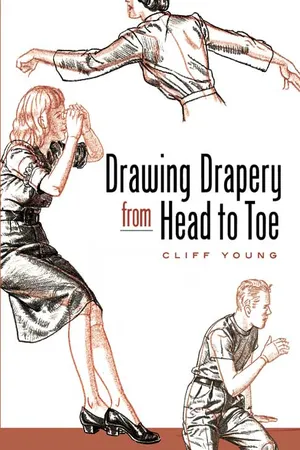
- 48 pages
- English
- ePUB (mobile friendly)
- Available on iOS & Android
eBook - ePub
Drawing Drapery from Head to Toe
About this book
Packed with indispensable information on a vital aspect of drawing, this time-honored manual offers expert guidance on how to draw shirts, pants, skirts, gloves, hats, coats, and undergarments on the human figure. Step by simple step, artists will discover how these garments fit and drape the body at rest and in action. Abundant with detailed illustrations, photographs, and diagrams, Drawing Drapery from Head to Toe familiarizes readers with the properties of cloth and how it moves; it also examines the origins of folds in relation to the figure, the effects of pull and crush, action folds, creasing, and more. The result: a keen development of the essential techniques for creating realistic, masterfully rendered drawings of the clothed figure.
One of few books on the subject of drawing drapery, this volume was written by a noted artist and instructor. Easy to follow, full of fascinating advice, and highly enjoyable to read, it is sure to become a well-thumbed guide.
One of few books on the subject of drawing drapery, this volume was written by a noted artist and instructor. Easy to follow, full of fascinating advice, and highly enjoyable to read, it is sure to become a well-thumbed guide.
Frequently asked questions
Yes, you can cancel anytime from the Subscription tab in your account settings on the Perlego website. Your subscription will stay active until the end of your current billing period. Learn how to cancel your subscription.
At the moment all of our mobile-responsive ePub books are available to download via the app. Most of our PDFs are also available to download and we're working on making the final remaining ones downloadable now. Learn more here.
Perlego offers two plans: Essential and Complete
- Essential is ideal for learners and professionals who enjoy exploring a wide range of subjects. Access the Essential Library with 800,000+ trusted titles and best-sellers across business, personal growth, and the humanities. Includes unlimited reading time and Standard Read Aloud voice.
- Complete: Perfect for advanced learners and researchers needing full, unrestricted access. Unlock 1.4M+ books across hundreds of subjects, including academic and specialized titles. The Complete Plan also includes advanced features like Premium Read Aloud and Research Assistant.
We are an online textbook subscription service, where you can get access to an entire online library for less than the price of a single book per month. With over 1 million books across 1000+ topics, we’ve got you covered! Learn more here.
Look out for the read-aloud symbol on your next book to see if you can listen to it. The read-aloud tool reads text aloud for you, highlighting the text as it is being read. You can pause it, speed it up and slow it down. Learn more here.
Yes! You can use the Perlego app on both iOS or Android devices to read anytime, anywhere — even offline. Perfect for commutes or when you’re on the go.
Please note we cannot support devices running on iOS 13 and Android 7 or earlier. Learn more about using the app.
Please note we cannot support devices running on iOS 13 and Android 7 or earlier. Learn more about using the app.
Yes, you can access Drawing Drapery from Head to Toe by Cliff Young in PDF and/or ePUB format, as well as other popular books in Art & Art Techniques. We have over one million books available in our catalogue for you to explore.
Information
FROM CLOTH . . .
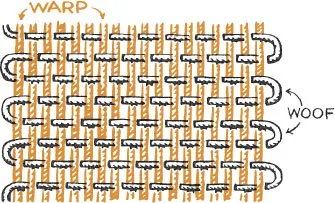
Drapery is cloth. You must know what cloth is. Cloth is made of threads woven together as shown in the illustration to the left. The threads may be of wool, cotton, silk, etc.
The length-wise threads, as shown in red, are called the WARP. The threads which are woven back and forth by the shuttle in the making of fabrics are known as the WOOF. These are the black threads shown in the illustrations to the left.
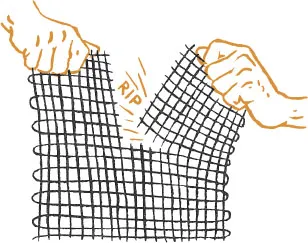
When cloth is torn the threads of the WARP or the WOOF are broken. See the illustration to the left. It is impossible to tear cloth diagonally. When a change in direction occurs in a tear, it is always at right angles to the WARP or WOOF.
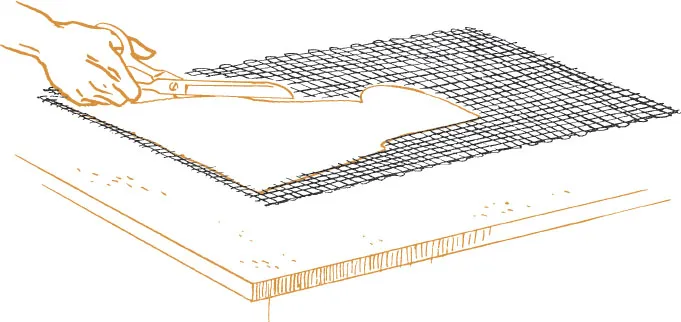
If it is necessary to have cloth of irregular shapes, the cloth must be cut to shape with a pair of scissors. The illustration above shows a paper pattern laid on cloth as a guide to cutting. These facts are known to all, but it is well to recall them to mind in order that you may know the nature of the material with which clothing is made.
. . . TO CLOTHES
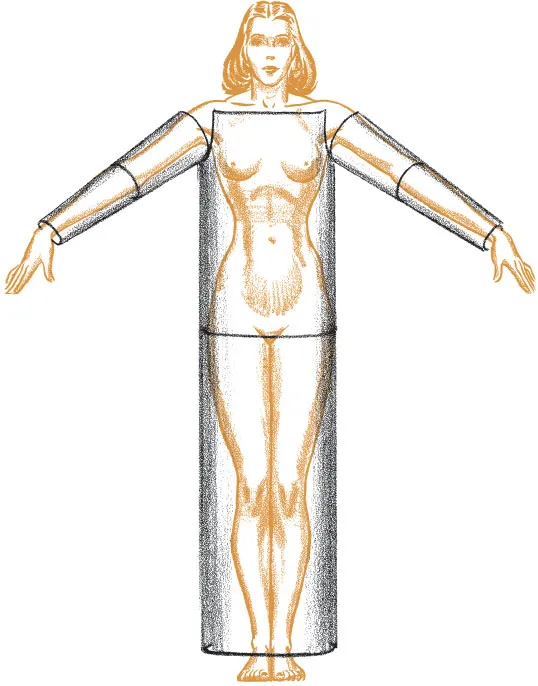
This figure is clothed in cylinders. A cylinder covers each arm—another covers the body and legs. The cylinders shown cover, but do not fit the figure.
Compare this diagram with your own clothes. Your sleeves are cylindrical—also the body of your jacket, coat, or shirt. Trousers and skirts carry out this cylindrical scheme.
DRAPERY
Clothes are simply pieces of cloth sewn together to make a covering for the nude figure. Study the force of gravity (downward pull) on one piece of cloth under many conditions. By doing this you may better understand the cause of the folds which seem to give so much trouble when drawing the clothed figure.
If you will take a piece of cloth a yard square and make various drawing of it, as shown by the drawings on the following pages, you will learn the cause and formation of folds which add interest to an otherwise plain piece of material.
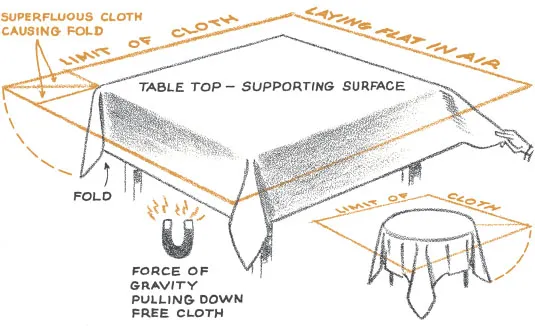
DRAPERY IN ACTION

A CLOTH LAID FLAT ON THE FLOOR AND PULLED FROM ONE CORNER WILL CAUSE FOLDS TO RADIATE FROM THIS POINT OF PULL.
WHEN THE CLOTH IS PULLED AT TWO CORNERS AT THE SAME TIME FOLDS WILL RADIATE FROM BOTH POINTS OF PULL. TRY IT AND SEE.
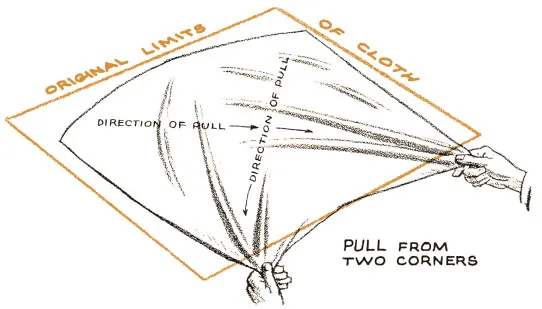
THE INFLUENCE OF . . .

THIS CLOTH HANGING ON THE WALL FROM TWO CORNERS HAS FOLDS RADIATING FROM EACH POINT OF PULL (TACK WHICH SUPPORTS CLOTH). GRAVITY, EXERTING A DOWNWARD PULL ON THE ENTIRE CLOTH, SEEMS TO INCREASE THE ‘PULL’ AT EACH UPPER CORNER.
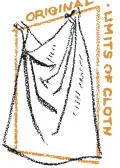
THIS IS THE SAME CLOTH SEEN FROM THE SIDE

THIS TIME THE TACKS SUPPORTING ...
Table of contents
- Cover
- Title Page
- Copyright Page
- Contents
- From Cloth to Clothes